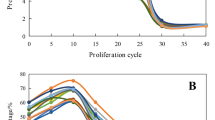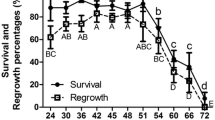Abstract
Compared to non-embryogenic callus, proembryonic mass, globular, and heart-shaped embryos of Eleutherococcus senticosus had higher levels of endogenous reduced glutathione (GSH). GSH content declined during the course of the embryo development (torpedo and cotyledon). Similarly, glutathione reductase that is involved in the recycling of GSH providing a constant intracellular level of GSH was also higher in globular and heart-shaped embryos. The transient increase in GSH contents also correlated with the changes in measured γ-glutamylcysteine synthetase activity over the same period. The endogenous levels of oxidized glutathione showed similar trend during development of the somatic embryos, whereas it declined in maturing somatic embryos. A pronounced increase in glutathione-S-transferase, glutathione peroxidase, catalase, and guaiacol peroxidase activity was observed during somatic embryo maturation. Ascorbate-glutathione cycle enzymes (ascorbate peroxidase; dehydroascorbate reductase and monodehydroascorbate reductase) activities also induced indicated that antioxidant enzymes played an important role during embryo development. These results suggested that the coordinated up-regulations of the antioxidant enzymes and glutathione redox system provide protection during somatic embryo development in E. senticosus. Antioxidant responses through alterations of the glutathione redox systems, have been described in the present studies have a significant role in somatic embryo development.




Similar content being viewed by others
Abbreviations
- APX:
-
Ascorbate peroxidase (EC 1.11.1.11)
- CAT:
-
Catalase (EC 1.11.1.6)
- 2, 4 D:
-
2, 4-dichlorophenoxyaceticacid
- DHAR:
-
Dehydroascorbate reductase (EC 1.8.5.1)
- DHA:
-
Dehydroascorbate
- γ-GCS:
-
Glutamylcysteine synthetase
- GST:
-
Glutathione-S-transferase (EC 2.5.1.18)
- GPx:
-
Glutathione peroxidase (EC 1.11.1.12)
- GR:
-
Glutathione reductase (EC 1.6.4.2)
- G-POD:
-
Guaiacol peroxidase (EC 1.11.1.7)
- MDHAR:
-
Monodehydroascorbate reductase (EC 1.6.5.4)
- GSH:
-
Reduced glutathione
- GSSG:
-
Oxidized glutathione
References
Aderkas PV, Bonga JM (2000) Influencing micropropagation and somatic embryogenesis in mature trees by manipulation of phase change, stress and culture environment. Tree Physiol 20:921–928
Aebi H (1984) Catalases. In: Bergmeyer HU (eds) Methods of enzymatic analysis 2. Academic Press, New York, pp 673–684
Asada K (2000) The water–water cycle as alternative photon and electron sinks. Philosophical Transactions of the Royal Society of London, Series B. Biol Sci 355:1419–1431
Belmonte MF, Donald G, Reid DM, Yeung EC, Stasolla C (2005) Alterations of the glutathione redox state improve apical meristem structure and osmotic embryo quality in white spruce (Picea glauca). J Exp Bot 56:2355–2364
Bewley JD, Black M (1994) Seeds. Physiology of development and germination. Plenum Press, New York
Bradford MM (1976) A rapid and sensitive method for the quantitation of microgram quantities of protein utilizing the principle of protein-dye binding. Anal Biochem 72:248–254
Chen GX, Asada K (1989) Ascorbate peroxidase in tea leaves: occurrence of two isozymes and the differences in their enzymatic and molecular properties. Plant Cell Physiol 30:987–998
Cordewener J, Booij H, van der Zett H, van Engelen F, van Kammen A, de Vries SC (1991) Tunicamycin-inhibited carrot somatic embryogenesis can be restored by secreted cationic peroxidase isoenzymes. Planta 184:478–486
Davydov M, Krikorian AD (2000) Eleutherococcus senticosus (Rupr. and Maxim.) Maxim. (Araliaceae) as an adaptogen: a closer look. J Ethnopharmacol 72:345–393
De Gara L, Tommasi F (1999) Ascorbate redox enzymes: a network of reactions involved in plant development. Recent Res Dev Phytochem 3:1–15
De Gara L, de Pinto MC, Moliterni VMC, D’Egidio MG (2003) Redox regulation and storage processes during maturation in kernels of Triticum durum. J Exp Bot 54:249–258
de Pinto MC, Francis D, De Gara L (1999) The redox state of the ascorbate-dehydroascorbate pair as a specific sensor of cell division in tobacco BY-2 cells. Protoplasma 209:90–97
Desikan R, Mackerness SAH, Hancock JT, Neill S (2001) Regulation of the Arabidopsis transcriptome by oxidative stress. Plant Physiol 127:159–172
Doulis AG, Debian N, Kingston-Smith AH, Foyer CH (1997) Differential localization of antioxidants in maize. Plant Physiol 114:1031–1037
Droter A, Phelps P, Fall R (1985) Evidence for glutathione peroxidase activities in cultured plant cells. Plant Sci 42:35–40
Fahey RC, Deena L, Di Stefano G, Meier P, Bryan RN (1980) Role of dehydration state and thiosulphide status in the control of thermal stability and protein synthesis in wheat embryo. Plant Physiol 65:1062–1066
Foyer CH, Noctor G (2005) Redox homeostasis and antioxidant signaling: a metabolic interface between stress perception and physiological responses. Plant Cell 17:1866–1875
Gardiner CS, Salmen JJ, Brandt CJ, Stover SK (1998) Glutathione is present in reproductive tract secretions and improves development of mouse embryos after chemically induced glutathione depletion. Biol Reprod 59:431–436
Gomez LD, Noctor G, Knight MR, Foyer CH (2004) Regulation of calcium signalling and gene expression by glutathione. J Exp Bot 55:1851–1859
Griffith OW (1980) Determination of glutathione and glutathione disulfide using glutathione reductase and 2-vinylpyridine. Anal Biochem 106:207–211
Halliwell B, Gutteridge JMC (2000) Free radicals in biology and medicine. Oxford University Press, Oxford, UK
Huang HC, Sherman MY, Kandror O, Goldberg AL (2001) The molecular chaperone dnaj is required for the degradation of a soluble abnormal protein in Escherichia coli. J Biol Chem 276:3920–3928
Hossain MA, Nakano Y, Asada K (1984) Monodehydroascorbate reductase in spinach chloroplasts and its participation in regeneration of ascorbate for scavenging hydrogen peroxide. Plant Cell Physiol 25:385–395
Jiménez A, Hernández JA, del Río LA, Sevilla F (1997) Evidence for the presence of the ascorbate–glutathione cycle in mitochondria and peroxisomes of pea leaves. Plant Physiol 114:275–284
Kumar HGA, Murthy HN, Paek KY (2002) Somatic embryogenesis and plant regeneration in Gymnema sylvestre. Plant Cell Tiss Org Cult 71:85–88
Martin KP (2003) Plant regeneration through somatic embryogenesis on Holostemma ada-kodien, a rare medicinal plant. Plant Cell Tiss Org Cult 72:79–82
Mittler R, Vanderauwera S, Gollery M, Breusegem FV (2004) Abiotic stress series. Reactive oxygen gene network of plants. Trends Plant Sci 9:490–498
Murashige T, Skoog F (1962) A revised medium for rapid growth and bioassays with tobacco tissue cultures. Physiol Plant 15:473–497
Neill SJ, Desikan R, Hancock JT (2002) Hydrogen peroxide signaling. Curr Opinion Plant Biol 5:388–395
Nocter G, Foyer CH (1998) Ascorbate and glutathione: keeping active oxygen under control. Annu Rev Plant Physiol Plant Mol Biol 49:249–279
Paek KY, Chakrabarty D, Hahn EJ (2005) Application of bioreactor system for large scale production of horticultural and medicinal plants. In: Hvoslef-Eide AK, Preil W (eds) Liquid culture systems for in vitro plant propagation. Springer, The Netherlands, pp 95–116
Pagila DE, Valentine WN (1967) Studies on the quantitative and qualitative characterization of erythrocytes glutathione peroxidase. J Lab Clin Med 70:158–169
Pütter J (1974) Peroxidases. In: Bergmeyer HU (eds) Methods of enzymatic analysis. Academic Press, New York, pp 685–690
Rentel MC, Knight MR (2004) Oxidative stress-induced calcium signaling in Arabidopsis. Plant Physiol 135:1471–1479
Rhazi L, Cazalis R, Lemelin E, Aussenac T (2003) Changes in the glutathione thiol-disulfide status during wheat grain development. Plant Physiol Biochem 41:895–902
Sanchez-Fernandez R, Fricker M, Corben LB, White NS, Sheard N, Leaver CJ, Van Montagu M, Inze D, May MJ (1997) Cell proliferation and hair tip growth in the Arabidopsis root are under mechanistically different forms of redox control. Proc Natl Acad Sci 94:2745–2750
Shohael AM, Chakrabarty D, Yu KW, Hahn EJ, Paek KY (2005) Application of bioreactor system for large-scale production of Eleutherococcus sessiliflorus somatic embryos in an air-lift bioreactor and production of eleutherosides. J Biotechnol 120:228–236
Smith IK, Vierheller TL, Thorne CA (1988) Assay of glutathione reductase in crude tissue homogenates using 5, 5′-dithiobis (2-nitrobenzoic acid). Anal Biochem 175:408–413
Smith J, Ladi E, Mayer-Proschel M, Noble M (2000) Redox state is a central modulator of the balance between self-renewal and differentiation in a dividing glial precursor cell. Proc Natl Acad Sci 97:10032–10037
Tommasi F, Paciolla C, de Pinto MC, De Gara L (2001) A comparative study of glutathione and ascorbate metabolism during germination of Pinus pinea L. seeds. J Exp Bot 362:1647–1654
Van Engelen FA, de Vries SC (1992) Extracellular proteins in plant embryogenesis. Trends Genet 8:66–70
Volohonsky G, Tuby CNYH, Porat N, Wellman-Rousseau M, Visvikis A, Leroy P, Rashi S, Steinberg P, Stark A (2002) A spectrophotometric assay of γ-glutamylcysteine synthetase and glutathione synthetase in crude extracts from tissues and cultured mammalian cells. Chem Biol Interact 140:49–65
Whetten RW, MacKay JJ, Sederoff RR (1998) Recent advances in understanding lignin biosynthesis. Ann Rev Plant Physiol Plant Mole Biol 49:585–609
Willekens H, Inzé D, Van Montagu M, Van Camp W (1995) Catalases in plants. Mole Breed 1:207–228
Wingate VPM, Lawton MA, Lamb CJ (1988) Glutathione causes a massive and selective induction of plant defense genes. Plant Physiol 87:206–210
Yeung EC (1995) Structural and developmental patterns in somatic embryogenesis. In: Thorpe TA (eds) In vitro embryogenesis in plants. Kluwer Academic Publishers, Dordrecht, The Netherlands, pp 205–249
Yeung EC, Brown DCW (1982) The osmotic environment of developing embryos of Phaseolus vulgaris. Z Pflanz 106:149–156
Yeung EC, Belmonte MF (2004) The effects of reduced and oxidized glutathione on white spruce somatic embryogenesis. In Vitro Cell Dev Biol Plant 40:61–66
Zhang J, Kirkham MB (1996) Antioxidant responses to drought in sunflower and sorghum seedlings. New Phytol 132:361–373
Acknowledgments
This work was financially supported by the Ministry of Education and Human Resources Development (MOE), the Ministry of commerce, Industry and Energy (MOCIE) and the Ministry of Labour (MOLAB), Republic of Korea through the fostering project of the lab of Excellency. One of the authors (MBA) wishes to acknowledge the Japanese Society for the Promotion of Science (JSPS) for providing financial assistance.
Author information
Authors and Affiliations
Corresponding author
Rights and permissions
About this article
Cite this article
Shohael, A.M., Ali, M.B., Hahn, E.J. et al. Glutathione metabolism and antioxidant responses during Eleutherococcus senticosus somatic embryo development in a bioreactor. Plant Cell Tiss Organ Cult 89, 121–129 (2007). https://doi.org/10.1007/s11240-007-9220-9
Received:
Accepted:
Published:
Issue Date:
DOI: https://doi.org/10.1007/s11240-007-9220-9




